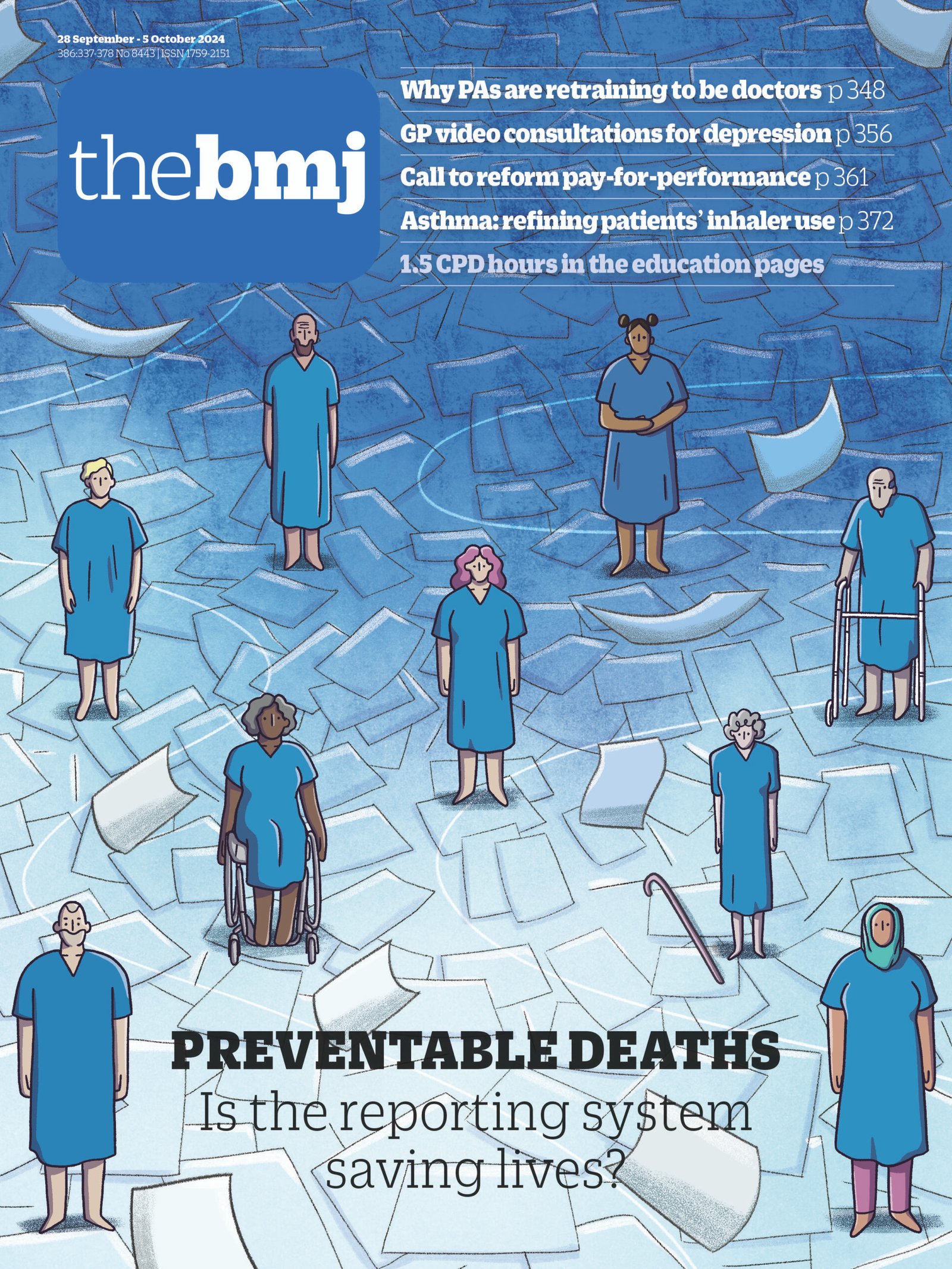
Racism is a scar on society. Social justice requires that we take the necessary action to deal with it and its effects on health. It is a profound injustice if the conditions for good health are unequally distributed, depending on the ethnic group to which people belong. Especially so, if that unequal distribution results from the evils of racism.
A new report on Structural Racism and Health in London gives answers to the question of what kind of society we want.1 The question was given new urgency in Britain this summer by the most appalling outbreak of racist fuelled violence. Our answer is clear: we want a society where all its members, whatever their ethnic background and country of origin, have the conditions and the freedoms to lead lives they have reason to value. One way we will know that is happening is for all groups in society to have the conditions for good health. It is those conditions for good health—the social determinants of health—that are the focus of this new report.
It’s possible to see the outbreak of violence as the behaviour of a few prejudiced individuals. Such behaviour is indeed reprehensible, but our concern is with something much more systematic: the way that structures of society enhance and perpetrate racism. This can be seen in the way that institutions operate to the systematic disadvantage of ethnic minority groups.
Language is important. If someone is labelled as Black or White, Asian or African, White British or other, there might be an unfortunate tendency to interpret the health patterns associated with those labels as properties of the individuals who comprise those groups. Neither the evidence nor the demands of social justice support that view. The inequalities in health, and in the social determinants of health, that our new report documents, reinforces that these patterns are a result of the organisation of society, which systematically disadvantages racially minoritised people based on their ethnicity, as well as their socioeconomic position, levels of disability, age, and gender.
Our review found striking differences among different groups, which reinforce the misleading nature of labels such as Black, Asian, and Minority Ethnic Groups. “Ethnic minority group” is, at best, a summary term—a pragmatic way of detecting patterns. It does not reflect the fundamental historical, ethical, socioeconomic, cultural, and political forces that give rise to structural racism.
Ethnic differences in health, by themselves, are not evidence of racism. Some groups may experience good health, despite experiences of racism; others might have ill health for other reasons, but these differences do give an indication, widely reported in accounts, that racism plays a part.
Three health patterns stand out. Reported ill health varies markedly. Our report found that in Gypsy or Irish Traveller communities, around 60% of women and 55% of men over 50 have a limiting illness or disability; for Bangladeshi women and men, the figures are over 45% and over 35%.2 By contrast, the figures for Chinese people are around 20%, similar to Indian men. The prevalence for Indian women is around the same as for White British men and women—just under a third.2
Secondly, there are clear ethnic differences in maternal and child health. Maternal mortality rates among Black women are almost three times higher than among White women and four times higher than among Chinese women; while women from Asian ethnic backgrounds are almost two times more likely to die than White women.3 Infant mortality rates also show clear ethnic differences: more than five per 1000 live births among those classified as Black African, Black Caribbean, and Pakistani; less than three per 1000 live births among babies classified as Indian and White British.4
The third health pattern that stands out is common mental disorder. For each ethnic group, women have a higher prevalence than men and, among women, there is a twofold range: higher in “Black,” lower in “White other.”5
Our report examines three ways in which racism can damage health. Firstly, is the direct effect of experiencing racism at the hands of institutions or individuals. Direct health impacts include psychological distress, poorer self-rated health, and hypertension. People who reported racial discrimination had, on average, poorer mental functioning scores four years later.6 Fear of experiencing racism, expressed through reporting feeling unsafe or avoiding spaces or places, had the biggest cumulative effect on the mental health of people from ethnic minority groups. Exposure over the life course, together with having to remain vigilant and the anticipatory stress of possible future racist encounters, is likely to continue affecting the mental health of people from ethnic minorities in the longer term.7
Secondly, racism can lead to ethnic inequalities in the social determinants of health. The 2010 Marmot Review pointed to six domains that provide explanations for health inequalities and areas that require action.8 The report uses these six as an organising framework and documents ethnic inequalities in each of these. Racism can affect each of them and these have cumulative impacts throughout life.
Child poverty is defined as living in a household at less than 60% median income, after taking housing costs into account. In Bangladeshi and Pakistani households around 70% of children live in poverty, compared with fewer than 30% in Indian, White, and Chinese households.9 We note the impact of housing costs on child poverty in London. Before the pandemic 37% of children were living in poverty after housing costs were taken into consideration. The steep cost of housing is driving people into poverty and affects all groups. Poverty is particularly harmful to health.
There are ample reports of racism in schools and, as expected, poverty shapes educational outcomes. Children eligible for free school meals have lower attainment throughout school. Among these children from low income families, the ethnic differences are revealing. For scores on reading, writing, and mathematics at Key Stage 2 (age 11), Chinese, Bangladeshi, Indian, and Black African children do well; White British, Irish, Irish Traveller, Gypsy or Roma do relatively poorly.10 It is clear that the ability of children to do well at school has little to do with what might be termed racial characteristics.
It is in accessing employment and levels of pay where ethnic inequalities become starkly apparent. For example, young Black people aged 16–24 have more than double the unemployment rate of young White people.11 There are many reports of racism related to recruitment, progression, treatment at work, and pay.
The third way that racism can damage health is through the operations of health and care systems, particularly ethnic inequalities and experiences of discrimination and racism in maternity and mental health services. The NHS Race and Health Observatory has shown that barriers to accessing NHS services for patients from ethnic minority backgrounds include lack of appropriate treatment for particular health issues; poor quality or discriminatory treatment from healthcare staff; lack of appropriate interpreting services; and delays in, or avoidance of, seeking help for health problems because of fear of racist treatment from NHS healthcare professionals.12 Lack of data on racism, ethnic inequalities, and health limit analyses.
Health is a window through which we can view the workings of society. This report on structural racism points to alarming differences in health and the social determinants of health among ethnic minority groups that urgently need to be tackled in the three ways we have laid out: combatting the directly damaging effects of racism, ensuring equitable distribution of the social determinants of health, and in access to health and care services. Vital to each of these is building trust with communities through meaningful engagement. Social justice requires it.
Footnotes
-
Competing interests: None declared.
-
Provenance and peer review: Not commissioned, not externally peer reviewed.
References
-
Stansfeld S, Clark C, Bebbington P, King M, Jenkins R, Hinchliffe S. (2016) Chapter 2: Common mental disorders. [book auth.] Jenkins R, Brugha T. (eds) McManus S. Bebbington P. Mental health and wellbeing in England: Adult Psychiatric Morbidity Survey 2014. Leeds. NHS Digital.







